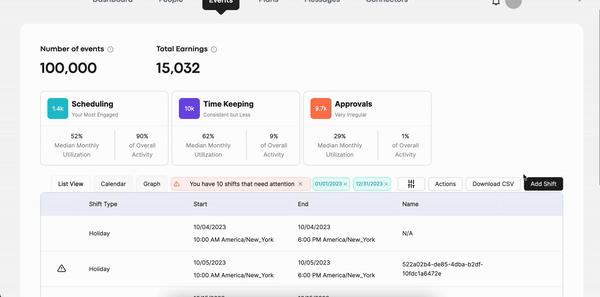A "no B.S." take on the state of AI for workforce ops in 2024
It's official. Gartner has placed AI at the Peak of the Hype Cycle as we exit 2023. This means two important things:
Whether they've said it or not, your leadership expects that you consider AI to automate everything to increase productivity "yesterday"
The same leadership will say that "we lost the human touch" when we hit the great Trough of Disillusionment on AI in 2024
Welcome to the "Damned if you do, Damned if you don't" phase of embracing new technology. Now what?
There are 3 core themes I'd love you to think about, in order to cut past the noise, hype around AI, and what it means for your team. These will be true in 2024, regardless of how leadership feels about AI in the days ahead.
You have to fix your workforce data problems, before you start talking about AI
The hype around conversational AI is real, so ignore it at your peril
Better forecasting, scheduling and analytics are emerging as "killer" uses cases for AI in workforce ops
- Fix the Workforce Data Problem before Talking AI
You know the neat feature your phone has, where it recognizes "duplicate" contacts that are just slightly different and lets you merge them with one click? It does that so if someone FaceTimes you, or calls you or emails you, you know it's all the same person.
You don't have that for your workforce data, and that's a problem. When you use one tool for timekeeping, another for scheduling, another for production and another for HR, you have no idea who is doing what. It's why you have those giant spreadsheets with fragile vlookups as your "CRM". No real and valuable automation can happen till you stop relying on vlookups. Period.
There are only 2 approaches to fixing this: you (a) consolidate all of tools under one vendor, and/ or (b) create a system of record for consolidating and making your workforce data talk to each other. In other words, get to building a "CRM" for your workforce that gives you a central view of people across your data stack.

If you don't do these two things, and if your production, people, payroll, timekeeping and scheduling data don't talk to each other, your organization isn't ready to leverage AI just yet, whether or not said AI is overhyped.
2. Embracing Conversational AI – and making it "talk" to your data
Think about all the Google Sheets and Forms and Notion Docs and Typeforms and Google Calendars that you're asking your workforce to engage with. This isn't the work they are paid to do. Heck, it's sifting through these isn't even the work you are paid to do.
One of the most incredible advances we've seen in the last year isn't necessarily that AI has gotten smarter- it's that it has gotten really good at "speaking human". This means that in stead of forms upon forms, you can now step into a very simple, natural and unified UI for your workforce to "talk" to your organization, all while interfacing with your data stack with even more sophistication than before.
Just take the simple example of how you collect availability from your workforce for scheduling. In stead of using forms, you can now do things like this.

Imagine this being the "co-pilot" for your workforce that you always wished they had. This is no longer sci-fi. It's here, and it's time you start experimenting with these for your most frequent, high back-and-forth workflows with your workforce.
3. Making Ops "Self-driving" in an upside-down economic environment
Several industries are facing massive workforce shocks- with too much demand or too little supply- and are realizing that the "old" ways of stitching schedules and people together manually everyday no longer work. To add fuel to the fire, there is less headcount, and lower budgets to be had in 2024. New approaches will be needed in understanding people's preferences, their availability, demand and other conditions, and doing things like forecasting, scheduling, payroll and incentives, and communication without a hundred spreadsheets and a thousand emails.
The beauty of Gen AI is that once you have this data together, AI is really good at forecasting, matching and predicting. Much better than what we'll ever be with our spreadsheets.

Once you fix your data problems, get on the predictive analytics bandwagon. Stat.
More asks for a real-time response and action to changes in demand, and changes in your workforce's preferences. No additional headcount. Less budget. That's the reality that we are walking into in 2024.
It's not time to bow to our robot overlords yet. But it's definitely time to start poking at them.
Kunal
